
Lhasa to Kathmandu overland tour is one of the most popular overland travel route in tibet. In this post we will write details about this tour route and explain about it in great detail to help travelers to make a travel planning to Tibet in ease.
Contact us for FREE Tibet travel planning
We are the experts in Tibet travel! We have many decades of experience traveling, climbing and trekking in Tibet. Use us for free Tibet trip planning, including what agencies to use, what travel routes to take, when to go, How to get to Tibet and more! Feel free to contact us at: info@thelandofsnows.com.
Road Trip from Lhasa to Kathmandu
The 900 kilometer route linking Lhasa with the Nepal border remains the most popular overland route in Tibet. The Friendship Highway follows the western portion of Chinese National Highway 318 and ends in the town of Kyirong, located close to the Nepal border. Due to the 2015 Nepal Earthquake, the new border crossing into Nepal is at Rasuwagadhi, replacing the old border at Kodari. Starting in Lhasa, this route goes through many of the most popular tourist spots that the Tibet Autonomous Region (TAR) has to offer.

The Jokhang Temple
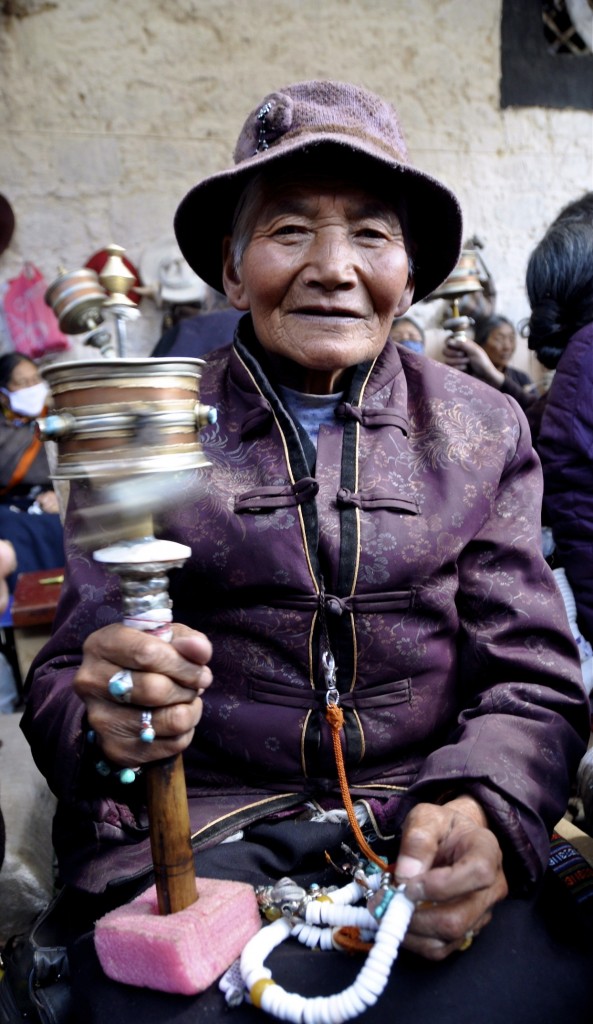
Pilgrim in Lhasa

Potala at night
Planning your journey
We get a surprisingly high amount of emails from across the globe from people who tell me they only have 4 or 5 days to spend in Tibet and they want to know if it is enough time to see Lhasa and travel along the Friendship Highway to the Nepal border. I always laugh when I get these types of emails! These people have spent so much money getting to Tibet and then want to rush through it leaving no time to really see what Tibet has to offer! For most people, Tibet is a once-in-a-lifetime trip. It is best to give yourself adequate time, not only to adjust to the high elevation, but to really experience the amazing culture and beauty of Tibet. I have been privileged to travel across the Friendship Highway dozens times. Though it can be done in fewer days, I recommend taking 10 to 12 days in going from Lhasa to Kathmandu (though the most I have taken is 21 days). The following itinerary allows you to acclimatize in Lhasa and to ascend in elevation at a safe pace. It also allows you to see much of what this amazing route has to offer, including some places that few others see!
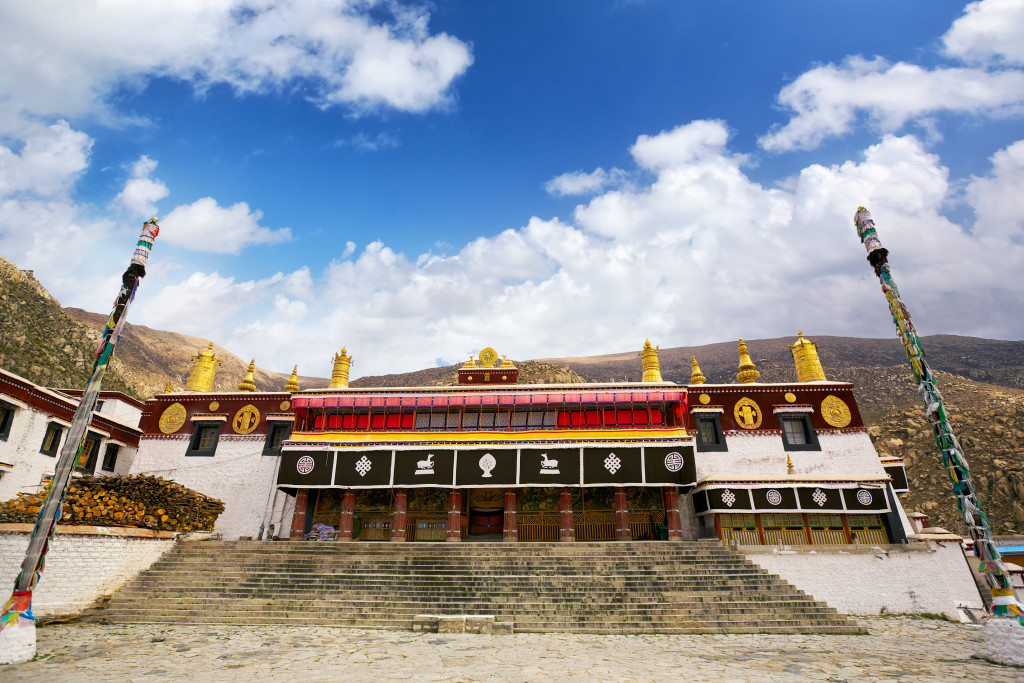
Drepung, one of Lhasa’s main monasterys
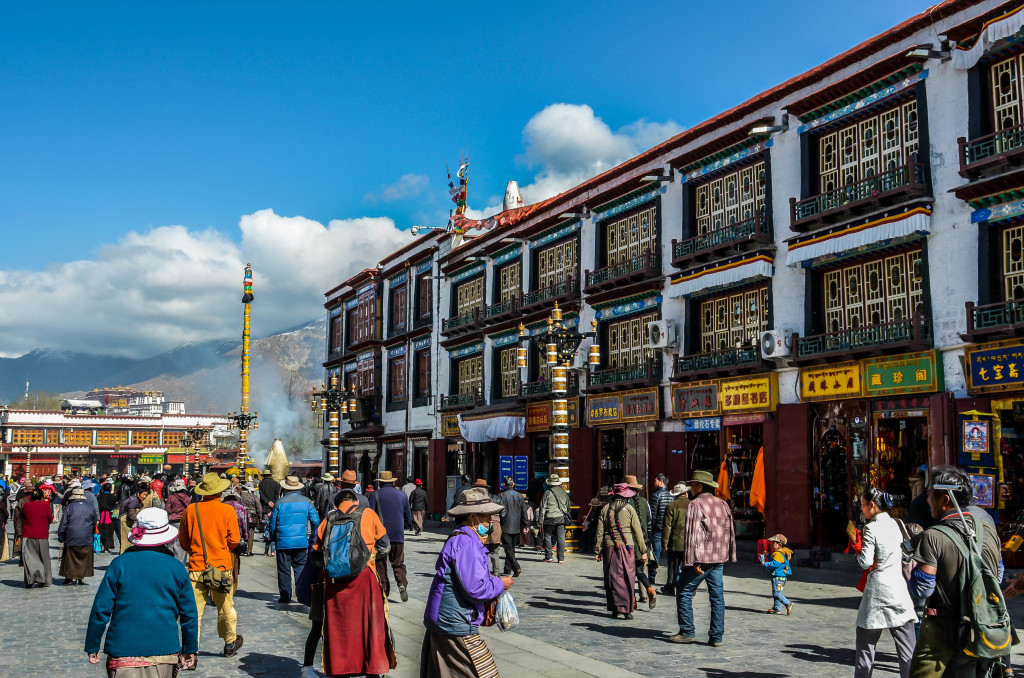
Around Lhasa’s Barkhor

Monks at Drepung
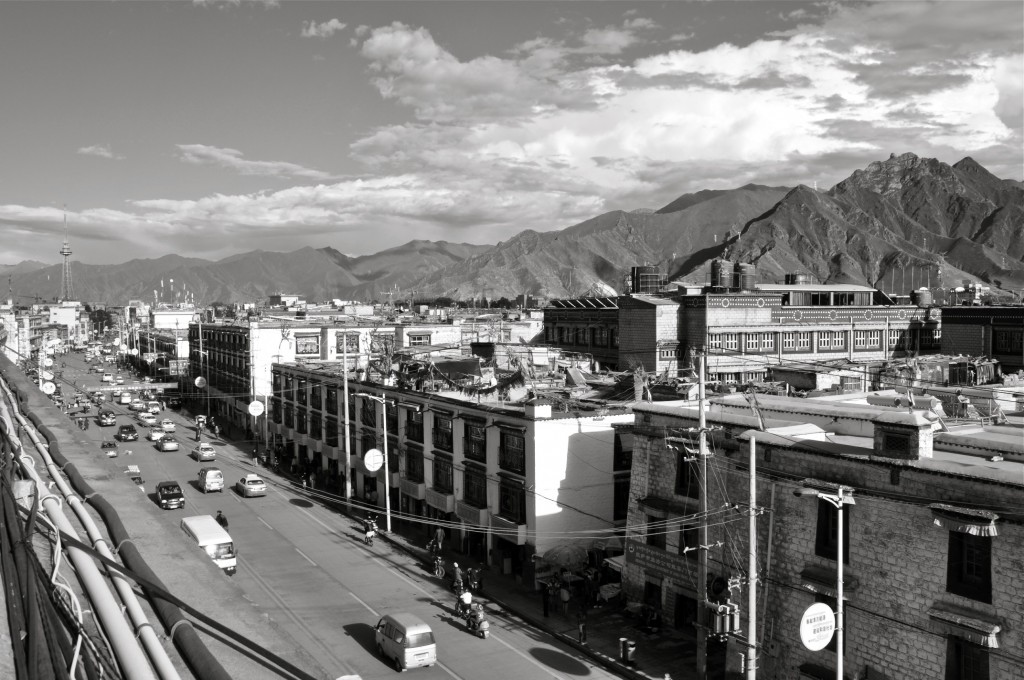
Old Town Lhasa
Itinerary going from Tibet to Nepal
Day 1: Arrive in Lhasa
The journey from Lhasa to Kathmandu will begin in the Tibetan capital city. The first day you arrive in Lhasa, it’s best to relax and take it easy. Lhasa sits at 3650 meters (12,000 feet) and has considerably less oxygen in the air than Chengdu, Beijing and even Xining. While there is no way of eliminating the risk of altitude sickness while in Tibet, you can drastically reduce the risk of severe symptoms by taking proper time to acclimatize.
Days 2 and 3: Explore Lhasa
Though Lhasa is now a large city and only has a small Tibetan Quarter, it is still a fun place to explore. Along with the most famous temples and monasteries in Tibet and the hum of thousands of pilgrims walking and prostrating around the Barkhor, Lhasa has many excellent restaurants, bars and hotels to choose from. I spending at least 3 nights in Lhasa. This is enough time for you to visit the main monasteries of Sera and Drepung as well as go to the Potala Palace, Jokhang Temple, Ramoche Temple, Ani Sangkhung Nunnery, Norbulinka, Nechung Monastery and spend plenty of time shopping and walking the pilgrimage circuits.
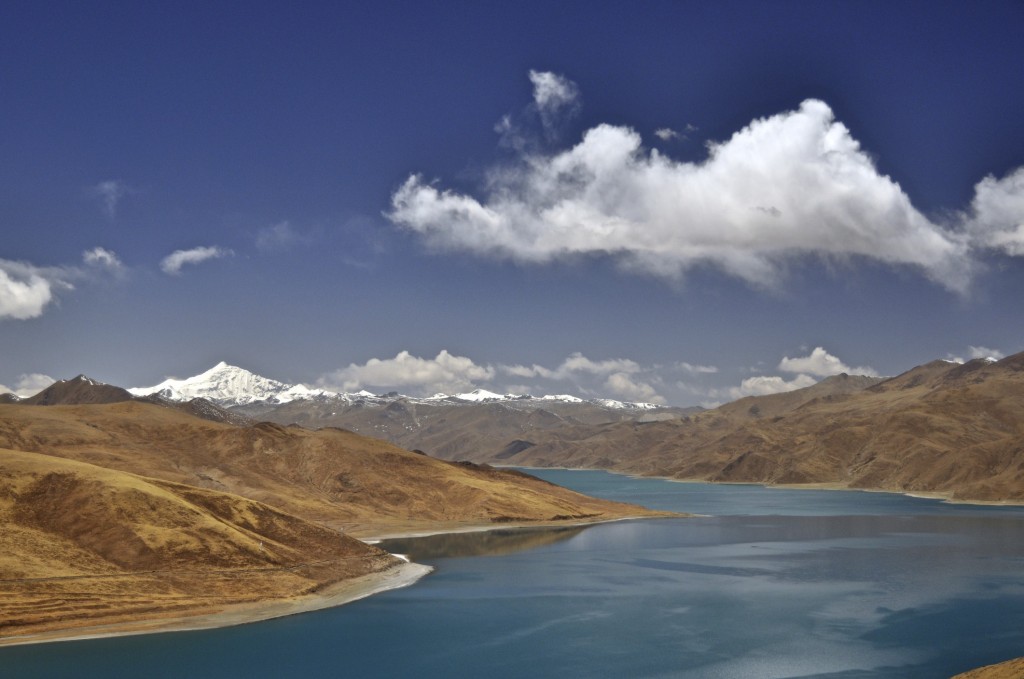
Yamdrok Lake

Gyantse Kumbum
Day 4: Lhasa – Yamdrok Lake – Gyantse Distance: 260 kilometers/162 miles
It’s now time to hit the road for the adventure of a lifetime! After leaving the city of Lhasa, you will drive southeast along the Kyi Chu River སྐྱིད་ཆུ་, a tributary of the Yarlung Tsangpo River ཡར་ཀླུངས་གཙང་པོ་. The first major site along the way is the scenic lake of Yamdrok. The turquoise colored lake lies at 4447 meters/14,590 feet. You first see the lake as you cross the 4700 meter/15,420 foot Kamba La Pass. In the distance beyond the lake, you get a fantastic view of the glaciated peak of Nojin Kangtsang rising to 7191 meters/23,593 feet.
Descending from the Kamba La Pass, the road follows alongside Yamdrok Lake to the small town of Nakartse སྣ་དཀར་རྩེ་. Though there are some decent accommodations here, I recommend just stopping here for lunch. About 10 kilometers/ 6 miles east of Nakartse is Samding Monastery བསམ་སྡིང་དགོན་པ་. This monastery has a sweeping view of the plains below as well as the mountains in the distance. Relatively few travelers stop here, but it is worth the short detour.
Leaving Nakartse or Samding Monastery, you continue driving east towards the Karo La Pass. This pass lies just under 5000 meters/16,400 feet and serves as the boundary between Lhoka prefecture ལྷོ་ཁ་ས་ཁུལ་ and Shigatse prefecture གཞིས་ཀ་རྩེ་ས་ཁུལ་ (not to be confused with the town of Shigatse). The high pass sits at the base of Mt. Nojin Kangtsang, the snow-capped peak viewed from above Yamdrok Lake. From this pass, you can get a great view of the glaciers as they stop just above the highway. There is a stupa here as well as thousands of prayer flags fluttering in the wind.
From the Karo La Pass, the road continues to descend to Gyantse རྒྱལ་རྩེ་. Gyantse, elevation 4025 meters/13,210 feet, is one of the most interesting towns in all of Tibet. The massive hilltop military fort called the Gyantse Dzong dominates the skyline. It is one of the best preserved “dzong” (fortress) remaining in Tibet. You can purchase an entry ticket and explore the old fort on your own. The other main attraction in Gyantse is the 35 meter high Gyantse Kumbum Stupa རྒྱལ་རྩེ་སྐུ་འབུམ. This stupa, one of the highest and largest in Tibet, is found on the grounds of the Pelkor Chorten Monastery དཔལ་འཁོར་མཆོད་རྟེན་དགོན་ Construction on the Gyantse Kumbum began in 1427. The stupa has 6 floors to explore, with each floor having several chapels. The Pelkor Chorten Monastery has many pilgrims from the surrounding area during Losar or Tibetan New Year, which is one of the best times to visit the region.
Though Gyantse is relatively small, there are a couple of good accommodation choices in town. My favorite is the Yeti Hotel, which offers discounts in the low season (November-April). Surprisingly, there are also some good restaurants in town. I prefer the Tashi Restaurant.
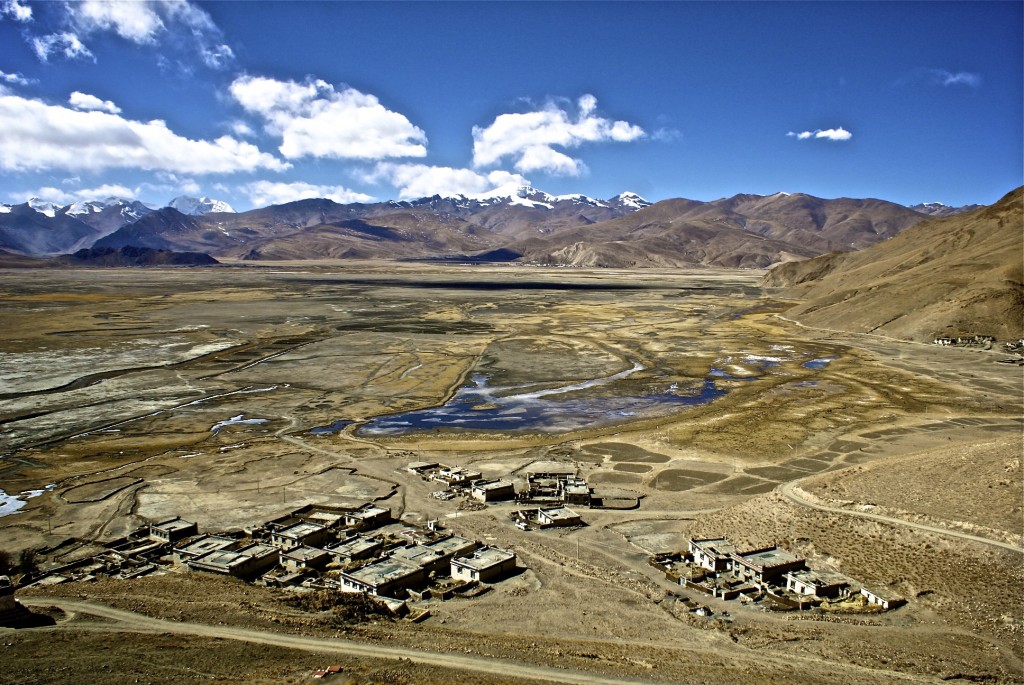
Samding Monastery

Pelkor Chorten Monastery
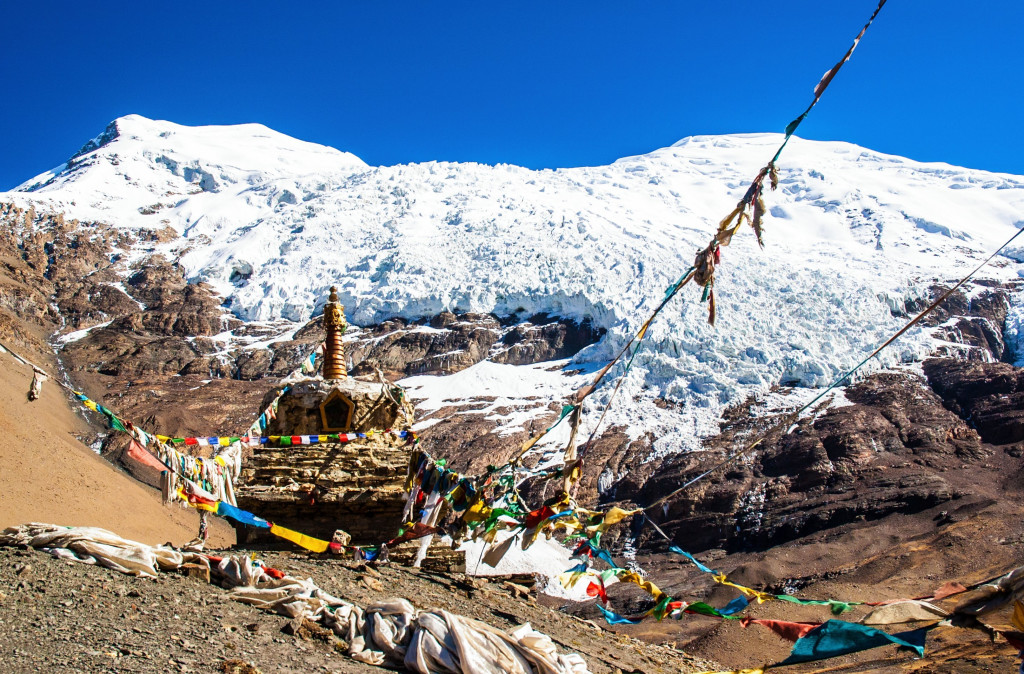
Karo La Glacier near Gyantse

Tibetan woman
Day 5: Gyantse – Shigatse Distance: 93 kilometers/58 miles
The short drive from Gyantse to Shigatse can be done in about 2 hours and passes through fertile plains where wheat and barley are grown. Shigatse གཞིས་ཀ་རྩེ་ is the second largest city in Tibet and is the former capital of the traditional Tibetan region of Tsang གཙང་. The traditional Tibetan region of Tsang is now found in the 18 county prefecture of Shigatse. Shigatse is a fairly modern city with a population of nearly 200,000 and sits at an elevation of 3845 meters/12,615 feet.
The main attraction in Shigatse is the Tashilhunpo Monastery བཀྲ་ཤིས་ལྷུན་པོ་དགོན. Tashilhunpo is of the 6 main monasteries of the Yellow Hat Sect of Tibetan Buddhism and was founded in 1447. Before the Cultural Revolution there were more than 4000 monks in residence here. Now there are around 600. Tashilhunpo Monastery is the home monastery of the line of Panchen Lamas པན་ཆེན་བླ་མ་, the most influential line of lama’s in Tibet after the Dalai Lama ཏཱ་ལའི་བླ་མ་. The tombs of the 5th through the 10th Panchen Lama’s are found within the huge monastery. Tashilhunpo is a major pilgrimage destination for Tibetans from across the plateau. The monastery sees the most pilgrims during New Year time, though there are usually at least a few hundred here each day throughout the rest of the year. There is an easy 1.6 kilometer/1 mile pilgrimage circuit lined with prayer wheels that goes around the outside of the monastery that is well worth hiking. It gives great views of the monastery and of the city of Shigatse. It is best to visit the monastery in the early morning as this is when it is the most active.
Nearby to Tashilhunpo Monastery is the newly rebuilt Shigatse Dzong གཞིས་ཀ་རྩེ་རྫོང་. The original was built in the early 17th century, but was destroyed in the 1960’s. Reconstruction of the Dzong began in 2005 and was completed in 2007. It was rebuilt in the same location and in the same design, but is slightly smaller than the original. For unknown reasons, the Shigatse Dzong had yet to open to tourists the last time I visited (late 2015), despite construction being finished.
The Walking Street, a few hundred meters before Tashilhunpo Monastery, is filled with souvenir shops, restaurants and tea houses. Be careful though…even though it is officially a pedestrian only street, there are still cars and motorcycles that come through.
Since Shigatse is a large, modern city, there are plenty of good accommodation choices. I almost always stay at the 4 Star Tashi Chortar Hotel, which offers great prices even in high season. Another good option just a short walk from Tashilhunpo Monastery is the Gang Gyan Shigatse Hotel. Good restaurants include the Third Eye, which is next door to the Gang Gyan, and the Songtsen Tibetan Restaurant, located on the Walking Street.
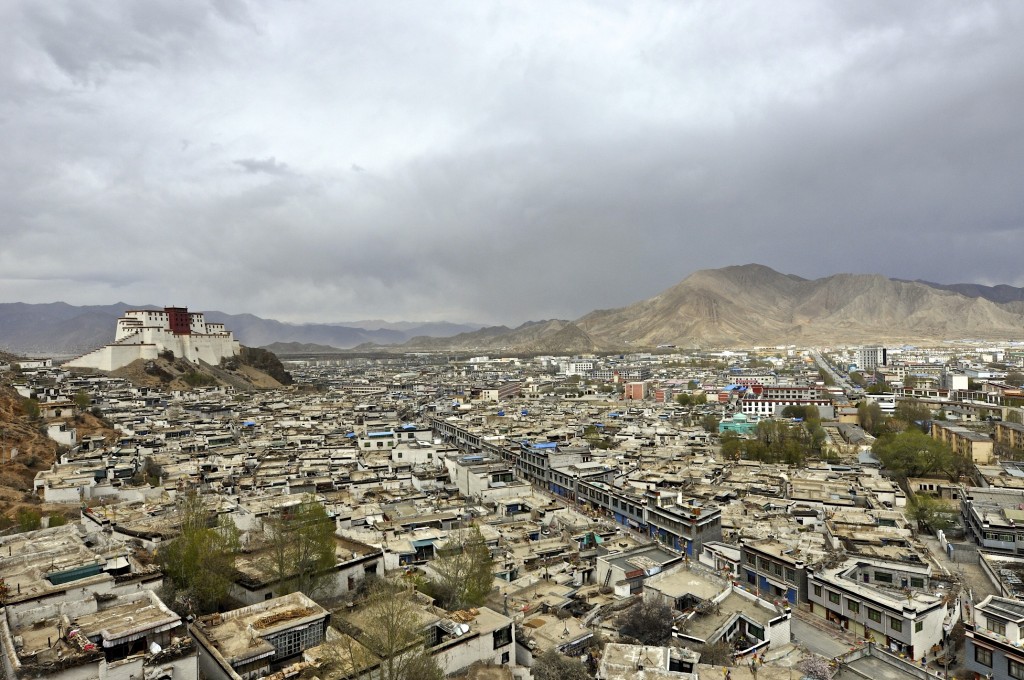
Shigatse

Tashi Lhunpo Monastery in Shigatse
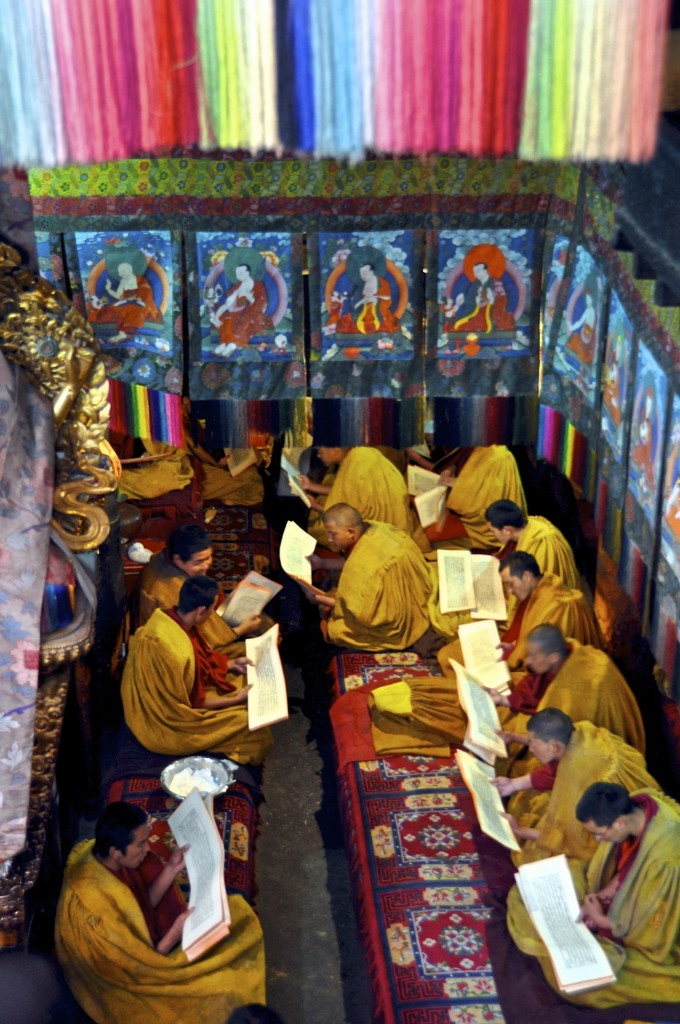
Monks at Tashilhunpo

Tashilhunpo Monastery

Tibetans spinning prayer wheels
Day 6: Shigatse – Sakya Monastery – Shelkar Distance: 282 kilometers/176 miles
After Shigatse, the route to the Nepal border continues west through small farming villages. Feel free to tell your guide to stop at one or two of these villages to explore them. These small villages can be a lot of fun! The main attraction along this route is the massive fortress-like monastery of Sakya ས་སྐྱ་དགོན་. Sakya Monastery is the seat of the Sakya Sect, one of the 4 main schools of Tibetan Buddhism. This monastery will look much different than the other monasteries you have seen so far along this route. The most obvious difference is the color of the monastery. Nearly all Sakya sect monasteries in Tibet are painted gray, white and maroon. Sakya Monastery is very old and was founded in the year 1073, though the main monastery is newer and was founded in 1268. The monastery is built like a fortress with high walls and watchtowers on the corners. It is one of the most impressive pieces of architecture in Tibet.
Sakya Monastery is located in Sakya county and is 25 kilometers/16 miles off of the main Friendship Highway. The town is quite small, but is fun to explore on foot. On the north part of town, there is a village as well as the ruins of the original monastery, which was founded in 1073. The newer part of Sakya town, elevation 4313 meters/14.150 feet, is fairly uninteresting and few people choose to stay here. There are a couple of hotels and restaurants if you do decide to stay here.
After Sakya Monastery, you will get back on the Friendship Highway and drive west towards the town of Lhatse ལྷ་རྩེ་. Lhatse, elevation 4025 meters/13,205 feet, is a good place to stop for lunch. I almost always eat at the Lhatse Tibetan Farmer’s Hotel, which has a decent restaurant serving simple Tibetan and Western food.
From Lhatse, it is a further 80 kilometers/50 miles to the town of Babar དབལ་འབར་, the last town of size before entering the Everest Nature Reserve. Baber is quite small, but has a couple of guesthouses and restaurants and a few small stores where you can stock up on simple supplies. Five kilometers northwest of Babar is Shelkar ཤེལ་དཀར་, a slightly larger town that few travelers take time to go to. Shelkar has an amazing mountain top Dzong (fortress) that lays in ruins. It is quite a hike getting to the top, but you will be rewarded with a view of Everest in the distance if you make it. There is a trail that leads the 2 kilometers or so to the top. Local guides can usually be hired around the village at the trailhead to take you to the top for around 100 RMB. There is also a small monastery along the trail, just a short hike past the trailhead.
The best place to stay in the Baber/Shelkar region is the Everest Qomolangma Hotel. Though this hotel has been here for many years, it remains the best option. The hotel offers clean rooms, WiFi, and has a dinner and breakfast buffet.

Using yaks to till

Shekar Dzong
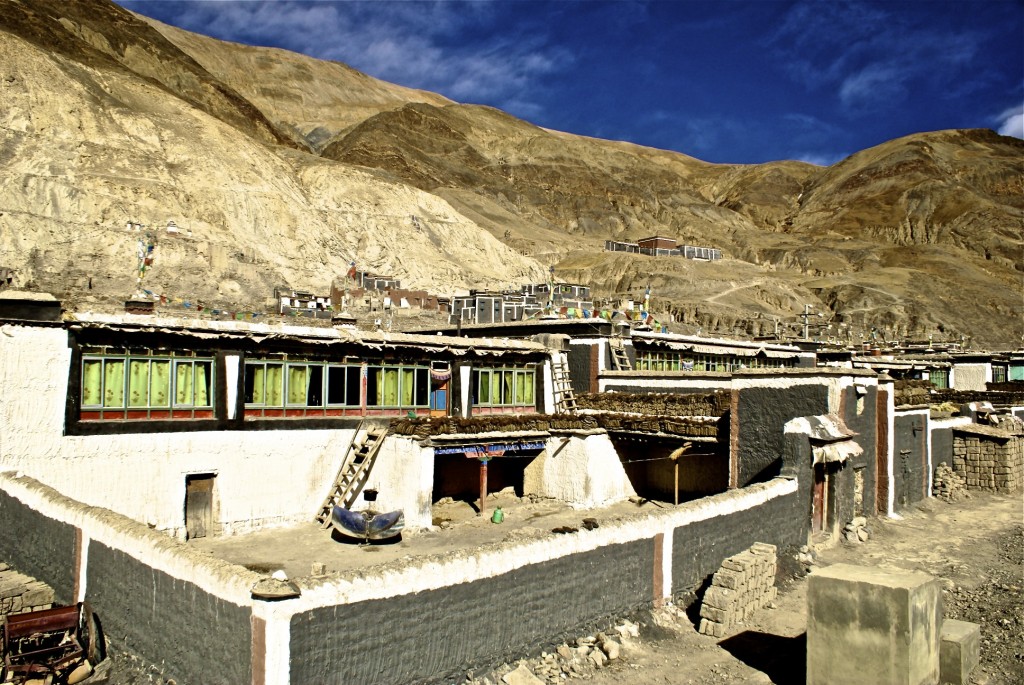
Village near Sakya Monastery

Sakya Monastery
Day 7: Shelkar – Geu La Pass – Everest Base Camp Distance: 112 kilometers/70 miles
Just outside of Baber, there is a military checkpoint where all travelers will need to register at. A few kilometers past the Babar checkpoint, the cut-off road to Everest Base Camp (EBC) appears. The first village you come to is called Chay, about 3 kilometers/2 miles past off of the cut-off. From Chay, it is just a short, but winding drive, to the top of the Geu La Pass (sometimes listed as the Pang La Pass). The Geu La Pass, sitting at 5200 meters/17,062 feet (some guide books list it a 5050 meters, but my altimeter and Google Earth both listed 5200 meters as the elevation), gives an amazing sweeping view of the Himalaya Mountains. This is truly one of the highlights of this overland journey! On a clear day, which is most days from October until mid May, you can get an excellent view of not only Everest ཇོ་མོ་གླང་མ་, but also of Lhotse (4th highest peak), Makalu (5th highest peak), Cho Oyu (6th highest peak), Shishapangma (14th highest peak) and Gyachung Kang (15th highest peak). For the best views, leave early in the morning so that you can see the sun rise across the Himalaya’s.
As you descend from the Geu La Pass, you will pass through several small villages. Forty kilometers past the Geu La Pass is the village of Basum, which has a guesthouse and a small store with simple supplies. About 32 kilometers past Basum, you arrive at Rongphu Monastery རྫ་རོང་ཕུ་དགོན་, the highest monastery in the world at 5000 meters/16,400 feet above sea level. There are a handful of friendly monks and nuns who live here year-round. Rongphu Monastery sits in front of a huge backdrop of Everest’s North Face. On a clear day, this is one of the most beautiful spots on the planet.
A few kilometers past Rongphu Monastery are the Everest Tent Hotels. This group of yak wool tents are the furthest that travelers are allowed to sleep who don’t hold a hiking or climbing permit for Everest. There are about 4 dozen or so “tent hotels” that all offer the same services (for the same prices) of a relatively clean bed, meals, drinks, snacks and souvenirs. This is also as far as your driver is allowed to go during the high season. From the tent hotels, you can hike a further 1 kilometer or so beyond the tents to a stone monument stating you are at base camp.
NOTE: During the low season from November through early April, the tent hotels are closed. There are simple accommodation options at Rongphu Monastery, though it would be best to stay at Basum where the guesthouses are considerably warmer. Also, your driver will be allowed to drive all the way to base camp during the winter months.
Though you probably won’t sleep well due to the elevation, staying at Everest Base Camp allows you to watch the sun set over Everest as well as rise on it the next morning. If you are having problems breathing at EBC, it is highly recommended that you descend to lower elevation. The small villages of Basum and Tashi Dzom are only a short drive away and are nearly 1000 meters/3280 feet lower than Everest Base Camp. Another option is to just visit EBC for a short while and then continue on to Old Tingri, which is also considerable lower than base camp.

Pangla Pass on the way to Everest
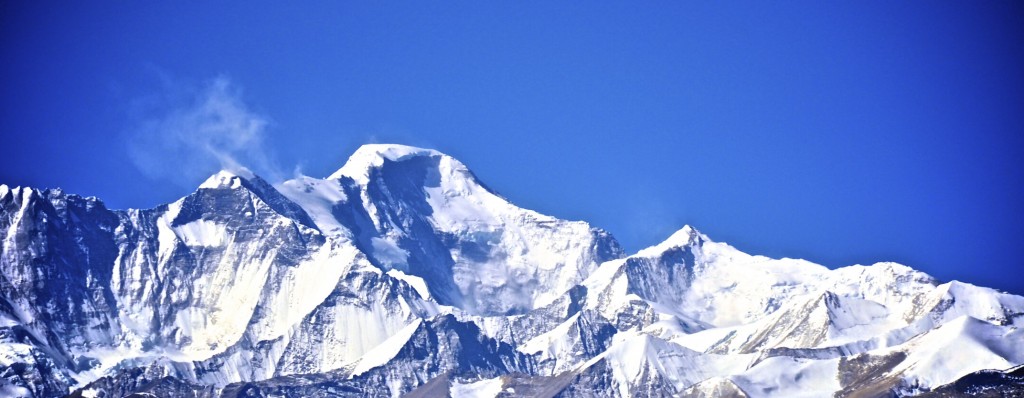
Cho Oyu
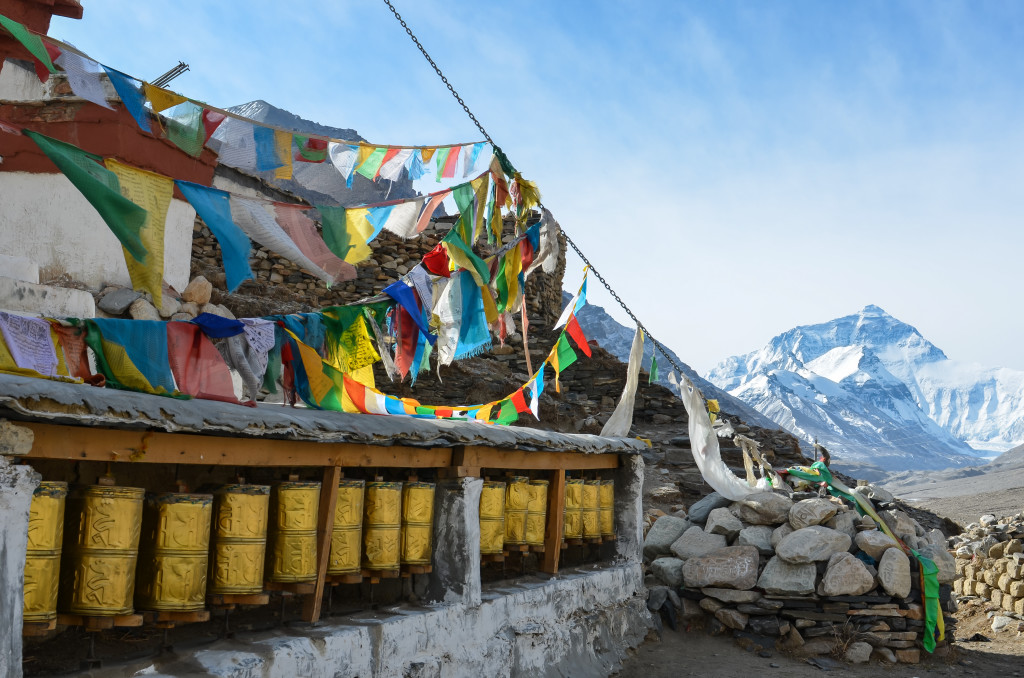
Everest viewed from Rongphu Monastery

Basum

North Face of Everest
Day 8: Everest Base Camp – Old Tingri Distance: 65 kilometers/41 miles
If your plan is not to continue from Everest Base Camp to Nepal, you would begin your return journey to Lhasa on this day. You can make it back to Lhasa in 2 long days. Otherwise, after you take your sunrise shots of Everest, you will continue on your Himalayan adventure. The drive from Everest Base Camp to Old Tingri isn’t far, but the road is a bit rough in spots. Also, there are a few nice villages to stop at and explore as well as other sweeping views of the Himalaya’s, particularly of Mt. Cho Oyu, the 6th highest peak.
Old Tingri is a small, one street town that doesn’t have a whole lot to see. However, after spending the night at Everest Base Camp, Old Tingri will be a welcomed site! There is a nice sweeping view of the Himalaya’s from the far west end of town that is quite spectacular. There are several guesthouses in town, though none are that great. I normally stay at the Kangar Hotel, which looks out to a sweeping view of the Himalaya’s, including Cho Oyu and Everest.
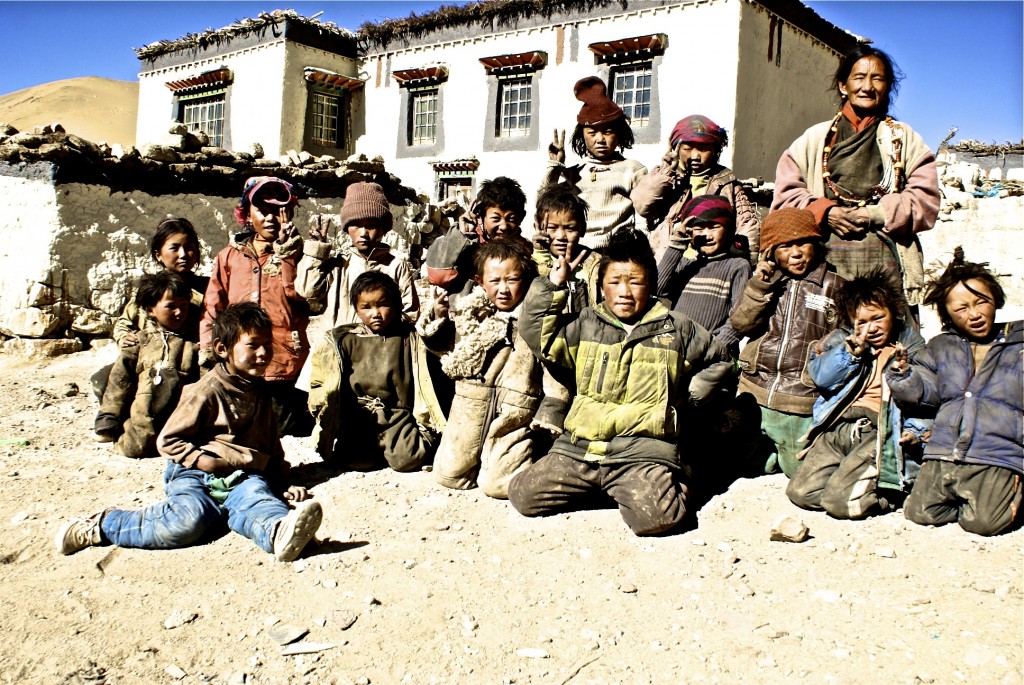
A village near Everest base camp

The Himalaya’s
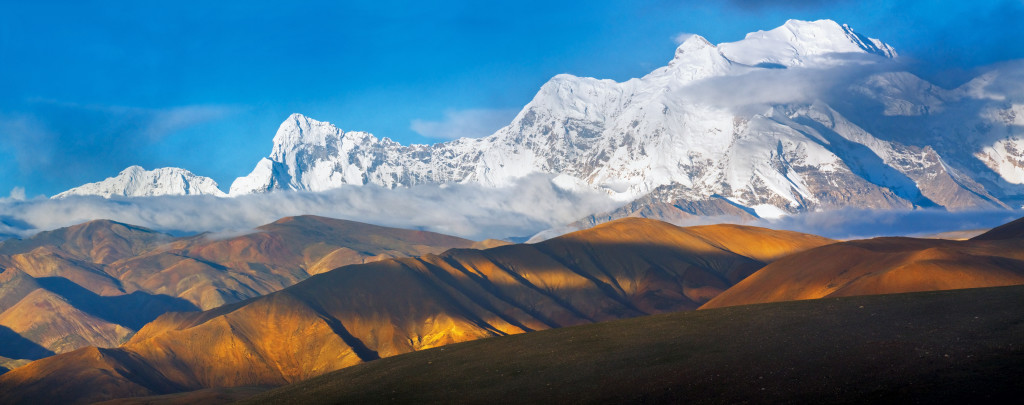
Mt. Shisha Pangma, the 14th highest peak
Day 9: Old Tingri – Peiku Lake – Shisha Pangma – Kyirong Distance: 260 kilometers/163 miles
From Old Tingri, you will continue following the Friendship Highway to the town of Kyirong near the Nepal border. The main border crossing from Tibet to Nepal is no longer near the town of Zhangmu (Dram in Tibetan), but is now at Kyirong. Along the drive, you will pass by the stunning lake of Peiku Tso, which offers a spectacular view of Shisha Pangma and many other giant Himalayan peaks. Shisha Pangma is the 14th highest peak on the planet.
Kyirong is not a very pleasant town and doesn’t have much to see or do, but serves as a good place to spend the night before crossing into Nepal.
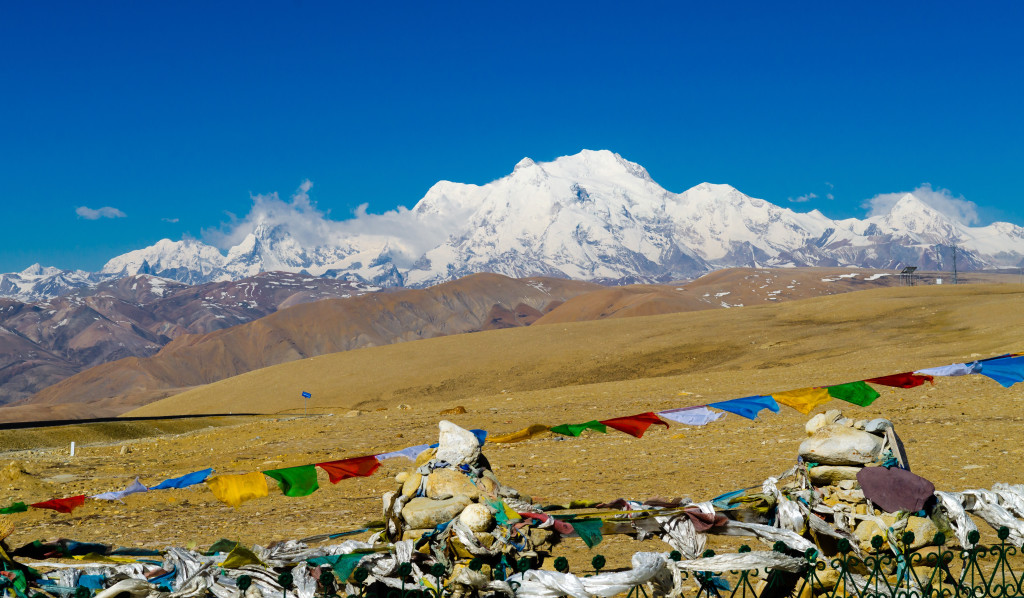
Shisha Pangma

Himalayas
Day 10: Kyirong – Sino-Nepali Border – Kathmandu Distance: 160 kilometers/100 miles
If you arrive in Kyirong in the late afternoon or early evening, it is best to stay the night and enter Nepal in the morning. The main reason is that the roads in Nepal are quite dangerous, especially at night. The drive from the Tibet-Nepal border to Kathmandu takes about 6 to 8 hours and I highly suggest avoiding this if you are going to be taking it at night.
The border crossing from Tibet to Nepal is not actually located in the town of Kyirong, but about 20 kilometers further south. The border opens at 9:30am Tibet time. Your driver and guide will lead you to the border crossing. For some odd reason, all of your bags will need to be inspected before you can leave Tibet. If you have any guidebooks on Tibet or anything with pictures of the Dalai Lama, it will most likely be taken. In 2009, I had my Lonely Planet Tibet guidebook taken from me with no real explanation given to me. Immigration is fairly straight forward and takes little time. At the Tibet side immigration, you will say goodbye to your guide and driver as they will not be crossing the border with you. Be sure to leave them a good tip, as is customary, for getting you safely across Tibet!
On the other side of the border you have arrived in Rasuwagadhi, the first village in Nepal. Most foreigners can obtain a visa-on-arrival in Rasuwagadhi. A 15 day tourist visa costs $25 USD, while a 30 day visa costs $40 USD. Payment can also be made in Chinese RMB or Nepali Rupee. You will need to also fill out a visa application form as well as submit 1 passport photo. Be aware that Nepal is 2 1/4 hours behind Tibet time.
From the Tibet border to Kathmandu is about 140 kilometers/88 miles. From Rasuwagadhi, there are several public buses that make the journey to Kathmandu. Vehicles from Tibet cannot cross into Nepal. Another more comfortable option is to hire a private jeep. If you are traveling with a group of 3 or 4, this is a good option as the price is quite reasonable and you can stop anywhere you want along the way to take pictures. Most agencies in Tibet can assist you in hiring a private vehicle to make the final leg of this journey.
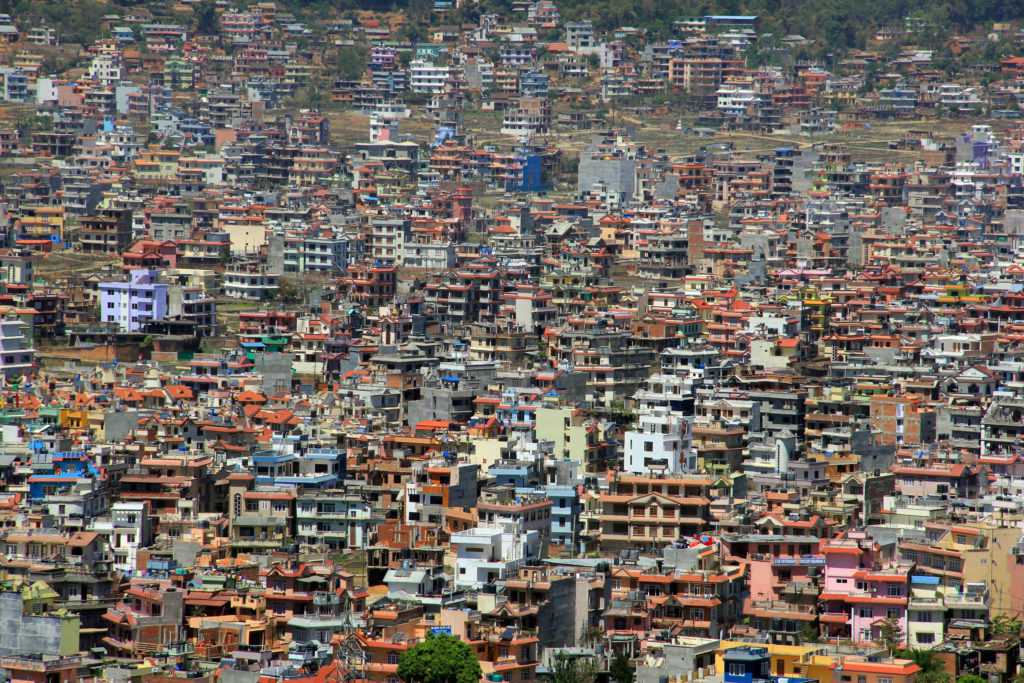
Kathmandu, Nepal
Organized Journey Required in Tibet
As with all travel in the Tibet Autonomous Region, the Friendship Highway requires that all foreigners be part of an organized tour that includes travel permits, a tour guide, a private vehicle and a driver. There are NO exceptions to this. There is a seasonal bus that runs from Lhasa to Kathmandu, but foreigners are NOT permitted to take it. This 10 day itinerary is just my recommendation. You can choose to modify this in anyway you like, however, We do recommend spending at least 3 nights in Lhasa to acclimatize and take at least 3 nights to get to Everest Base Camp to minimize the risk of serious altitude sickness.
Lhasa to Kathmandu Group Tours
If you are a budget travelers and looking to join a group in order to save cost on the Tour guide and Vehicle. There are Great number of travel agencies in Tibet offering group tour. We can recommend you travel agency.
Contrary to popular belief, the Friendship Highway is open year round and only very rarely closes to heavy snow. It is unlikely you will have any problems taking this route in the winter. Also, nearly all of the Friendship Highway is now paved. There are only small sections that remain dirt.
The journey from Lhasa to Kathmandu is one of the best overland routes in Tibet and really, in the world. Summer time can bring heavy clouds, limiting your views of Everest and the Himalaya’s. This is the reason I recommend doing this route in the low season, which is from mid-October until late April. During this time, the weather is generally clear and dry allowing good views of the mountains.
We have done this route many, many times over the past 15 years. If you have any questions about it or want a recommendation on which travel agency to use, feel free to email me at info@thelandofsnows.com
Lobsang བློ་བཟང་

Boudha Stupa in Kathmandu
